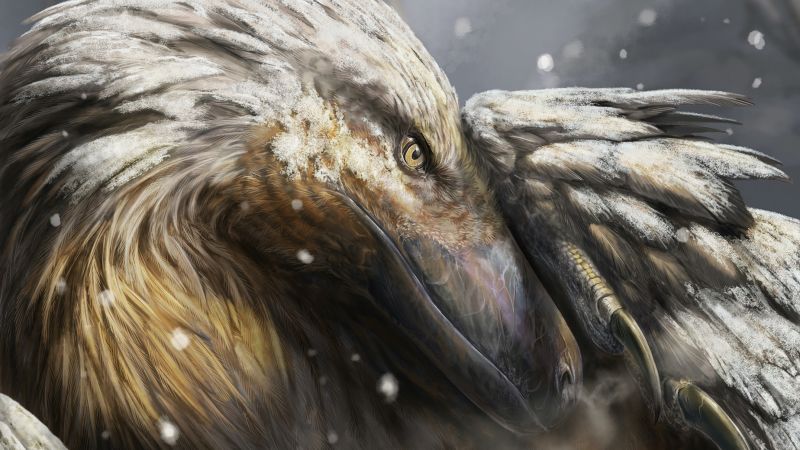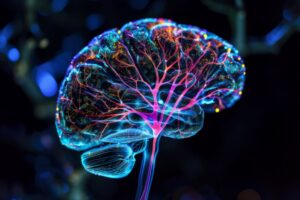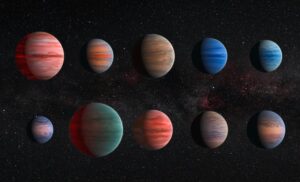Sign up for CNN’s Wonder Theory science newsletter. Explore the universe with news of fascinating discoveries, scientific breakthroughs and more.
CNN
—
Were dinosaurs warm-blooded like birds and mammals or cold-blooded like reptiles? This is one of paleontology’s oldest questions, and finding an answer is important because it illuminates how prehistoric creatures may have lived and behaved.
Challenging the prevailing idea that they were all slow, clumsy lizards that basked in the sun to regulate their body temperature, research over the past three decades has revealed that some dinosaurs were probably bird-like, with feathers and perhaps the ability to generate their own body heat.
However, it is difficult to find evidence that shows beyond doubt what the dinosaurs’ metabolism was like. Clues from dinosaur eggshells and bones suggest that some dinosaurs were warm-blooded and others were not.
A new study published in the journal Current Biology on Wednesday suggests that three major groups of dinosaurs adapted differently to changes in temperature, with the ability to regulate body temperature evolving in the early Jurassic period about 180 million years ago.
Based on fossils from 1,000 species of dinosaurs and information on paleoclimate, the new study looks at the distribution of dinosaurs in different environments on Earth during the Age of Dinosaurs, which began about 235 million years ago and ended 66 million years ago when an asteroid hit Earth.
Two of the three major groups — the carnivorous theropod dinosaurs, which include T. rex, and the herbivorous ornithischians, whose notable members include Triceratops and Stegosaurus — spread out to live in colder climates during the early Jurassic period, the study suggests. These dinosaurs may have evolved endothermy, or the ability to generate internal body heat, according to the study.
Sarah Maisonnier/Reuters
Visitors look at the skeleton of a giant triceratops, more than 66 million years old, called “Big John”, on display ahead of its sale at the Drouot auction house in Paris in October 2021.
Theropods and ornithischians lived in a wide range of thermal landscapes in their respective evolutionary histories and were “remarkably adaptable,” the researchers wrote. Recent fossil discoveries show that different species of dinosaurs even thrived in the Arctic, giving birth and living there year-round.
“Warm-blooded animals tend to be more active, for example cold-blooded animals tend not to build nests,” said lead study author Dr Alfio Alessandro Chiarenza, a Royal Society Newton International Fellow in the Department of Earth Sciences at University College London.
By contrast, the towering, herbivorous sauropods kept to warmer, lower-latitude regions of the planet, and the presence of richer foliage in certain habitats wasn’t the only factor, the study found. Sauropods, which include Brontosaurus and Diplodocus, also appear to have thrived in dry, savanna-like environments and practiced “prolonged climatic conservatism,” the researchers wrote.
“It fits well with what we imagine their ecology is,” Chiarenza said. “They were the largest land animals that ever lived. They would probably overheat if they were hot blooded.
Moreover, he added, the amount of plant matter they would have to consume if they were warm-blooded would be unsustainable.
“(These animals) lived in herds and we know that each one of them is equivalent to 10 African elephants. (If they were warm-blooded) they would simply destroy the plant life. It makes more sense as living animals that they should be more cold-blooded.’
However, Jasmina Wieman, a postdoctoral fellow at the Chicago Museum of Natural History, said the findings of this study contrasted with her own research, which looked at molecular traces of oxygen uptake found in dinosaur fossils. Her 2022 study suggested that ornithischians were more likely cold-blooded and sauropods were warm-blooded.
She questioned the extent to which a dinosaur’s biogeographic range was determined by its metabolic capacity as opposed to other factors such as behavior, growth strategy, dietary preferences, and other ecological interactions.
“Some animals with incredibly fast growth rates (i.e., sauropods) and, by necessity, fast metabolisms here turn out to be cold-blooded, while other animals with very slow growth rates (i.e., ceratopsians) recover as endotherms,” Wiman said. . “These inconsistencies will need to be addressed.”
Chiarenza said the model, developed by researchers at UCL and the Universidade de Vigo in Spain, suggests that the earliest dinosaurs were more reptilian and cold-blooded. But a period of global warming from volcanic activity 180 million years ago, known as the Jenkins Event, may have been the trigger for the development of the body’s ability to generate internal heat.
“Many new groups of dinosaurs appeared at that time. The adoption of endothermy, perhaps as a result of this ecological crisis, may have allowed theropods and ornithischians to thrive in colder environments, allowing them to be very active and maintain activity for longer periods, to develop and grow faster and produce more offspring,” he said in a news release.
As with all model-based research, the study made predictions based on existing information. New fossils or climate information may change this picture. “Certainly if a sauropod turns up in the Arctic, that would change things,” Chiarenza said.
Paleontologist Anthony Fiorillo, executive director of the New Mexico Museum of Natural History and Science, said the study was “intriguing” and “the first real attempt to quantify broad patterns that some of us have thought about before.” Fiorillo, who is also a senior fellow at Southern Methodist University in Dallas, was not involved in the research.
“Their modeling helps build resilience in our biogeographical understanding of dinosaurs and their associated physiology,” he said.
“This study provides us with a platform to further test what we think we may know.”



